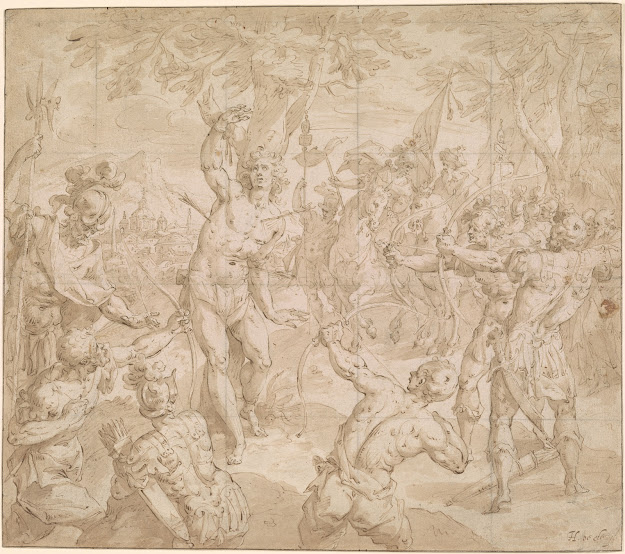 |
| Hans Franckenberger the Elder St John the Evangelist 1519 drawing Art Institute of Chicago |
 |
| Frans Pourbus the Elder God showing the Promised Land to Moses ca. 1565-80 drawing private collection |
 |
| Frans Pourbus the Elder Portrait Study of painter Frans Floris ca. 1570 drawing Hermitage, Saint Petersburg |
 |
| Bartholomeus Spranger Personification of Faith ca. 1567-75 drawing Museu Nacional de Arte Antiga, Lisbon |
 |
| Bartholomeus Spranger Cupid and Psyche before 1611 drawing British Museum |
 |
| Bartholomeus Spranger Study for Mercury, Venus and Cupid before 1611 drawing British Museum |
 |
| Bartholomeus Spranger Venus and Cupid before 1611 drawing British Museum |
Bartholomeus Spranger (1546-1611) – Antwerp-born painter, one of the most influential practitioners of international Mannerism. In 1565 he went to Italy, working for some time in Parma, where the example of Correggio and Parmigianino taught him sfumato and a particularly supple and elegant mode of figure drawing. In 1570 he was appointed painter to Pope Pius V in Rome. On the recommendation of his compatriot, Giovanni Bologna [the sculptor Giambologna], Spranger entered the service of the Hapsburg emperor Maximilian II in Vienna (1575). When Maximilian died only a few months after his arrival, Spranger was taken into the employ of his successor, Rudolph II, and moved (1581) with the imperial court to Prague. Rudolph was one of the great collectors of curiosities and rarities in the arts and in the natural and occult sciences. He patronized an overwhelmingly secular, refined and often erotic art, favouring representations of the female nude. Thus Spranger's oeuvre, little of which is to be found outside what were formerly the imperial collections, consists largely of mythological or allegorical images. . . . While in Rome, Spranger had made the acquaintance of his countryman Karel van Mander. In 1577 Spranger invited Van Mander to Vienna to assist him preparing decorations for Rudolph's investiture; in thanks, he gave Van Mander drawings, which the latter took with him when he emigrated in 1583 to Haarlem. There, Van Mander showed the drawings to his new friend and associate Goltzius, whom they influenced profoundly [as seen directly below]. Goltzius's engravings after Spranger's designs are the fountainhead not only of Haarlem Mannerism but of an international vogue, influencing artists throughout northern Europe, Italy and the Iberian peninsula.
– Erika Langmuir and Norbert Lynton, Yale Dictionary of Art and Artists (2000)
 |
| Hendrik Goltzius Bust of Angel 1609 drawing Getty Museum, Los Angeles |
 |
| attributed to Hendrik Goltzius Head of Woman ca. 1610 drawing private collection |
 |
| Hendrik Goltzius Two Studies of Model with Lifted Chin before 1617 drawing private collection |
 |
| Hendrick de Clerck Arithmetica before 1630 drawing private collection |
 |
| Hendrick de Clerck Martyrdom of St Sebastian before 1630 drawing Morgan Library, New York |
 |
| Livio Mehus Study for David with Sling before 1691 drawing private collection |
 |
| Livio Mehus Study for David before 1691 drawing private collection |
 |
| Livio Mehus Self Portrait ca. 1650-60 drawing private collection |